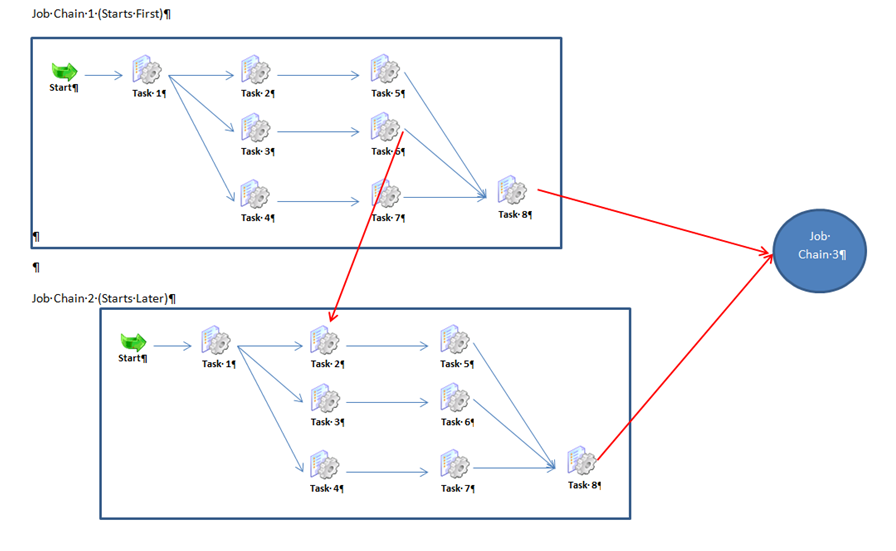Example: Synchronization of multiple Job Chains (crossover)
The following scenario is given:
- First Job-Chain-1 is started with a start node and 8 tasks, some of them running in parallel.
- Somewhat later Job-Chain-2 is started, also with a start node and 8 tasks, some of them also running in parallel.
- Processing of both these job chains is also synchronized in a way that a task in one chain (Task 2 in Job-Chain-2) is waiting for the end of a task in the other chain (Task 6 in Job-Chain-1)
- Both chains have to end successfully before Job-Chain-3 will start.
Creating job chains
Job-Chain-1, Job-Chain-2 und Job-Chain-3 are implemented in JobScheduler as job chains by using editor JOE (JobScheduler Object Editor).
For the implementation the following names are used:
- JobChain1: JobChain-Interlink-1 with the jobs JobInterlink-1-<n> , <n>=1-8
- JobChain2: JobChain-Interlink-2 with the jobs JobInterlink-2-<n> , <n>=1-8
- JobChain3: JobChain-Interlink-3 with job JobInterlink-3-1
Under Best Practice you may find some useful informations for creating job chains.
Parallel processing within the job chains
Parallel processing is realized by Split jobs and Sync-Jobs - as it is described in the Example for parallel execution in a job chain example.
The /sos/jitl/JobChainSplitter job in the ./live/sos/jitl directory is used for the splitter job, which is part of the JobScheduler download.
The com.sos.jitl.sync.JobSchedulerSynchronizeJobChainsJSAdapterClass JAVA class is used in the sync jobs.
Synchronization of the JobInterlink1 and JobInterlink2 job chains
According to request the job jobInterlink-2-2 starts only when the job jobInterlink-1-6 is successfully completed. Therefore we need a sync state after the job jobInterlink-1-6 and before the job jobInterlink-2-2 with the identical state name Sync_Interlink1_Interlink2.
As soon as the job jobInterlink-1-6 has finished, the synchronization is activated, the subsequent job jobInterlink-2-2 starts running and the branch of the parallel processing including job jobInterlink-1-6 comes to its sync state.
Synchronization before the start of the third job chain
The third job chain is to be started only when both predecessor job chains JobInterlink1 and JobInterlink2 are finished successfully. This dependency is also realized with a sync job. We define the sync job Sync_Interlink12_Interlink3 and inserted the node after the jobs jobInterlink-1-8 and jobInterlink-2-8 in the predecessor job chains and before jobInterlink-3-1 in the job chain which is to be started.
Parameter for sync job
Since JobScheduler version 1.7 the functionality of the JAVA class com.sos.jitl.sync.JobSchedulerSynchronizeJobChainsJSAdapterClass has been extended in a manner that it is possible now to define a context for a sync job , i.e. synchronization job is only valid within the job chain where the sync node is defined. For synchronization in parallel processing (Split/Sync-combination) the context is restricted to the job chain automatically. Therefore for a synchronization between job chains defined within parallel processing this restriction has to be ignored by using the paramater disable_sync_context=true.
Graphic of the implemented job chains

Creating orders with a starter job chain
Each of the three job chains requires an order to start. In this example we have a starter job chain with one job for each chain with this job generating the order.
In these jobs the order command is used as paramter with the name of the job chain. If necessary the path under the LIVE folder could be included.
<?xml version="1.0" encoding="ISO-8859-1"?>
<job title="Start JobChain via Command" order="yes">
<params />
<script language="shell">
<![CDATA[ echo ========== Generate Order for JobChain-Interlink-1 ========== exit 0 ]]>
</script>
<run_time />
<commands on_exit_code="error"/>
<commands on_exit_code="success">
<order job_chain="/Schulung/Aufgabe_verlinkte_Ketten/JobChain-Interlink-1" replace="yes"/>
</commands>
</job>
Another way to generate an order would be to use a script. For example:
<?xml version="1.0" encoding="ISO-8859-1"?>
<job stop_on_error="no" order="yes" title="Order für JobChain Interlink-1 erstellen (script)">
<script language="javax.script:rhino">
<![CDATA[
function spooler_process()
{
var order = spooler.create_order();
spooler.job_chain( '/Schulung/Aufgabe_verlinkte_Ketten/JobChain-Interlink-1' ).add_order( order );
return true;
}
]]>
</script>
<run_time />
</job>
Downloads
This example can be downloaded here: synchronization_jobchains.zip.

